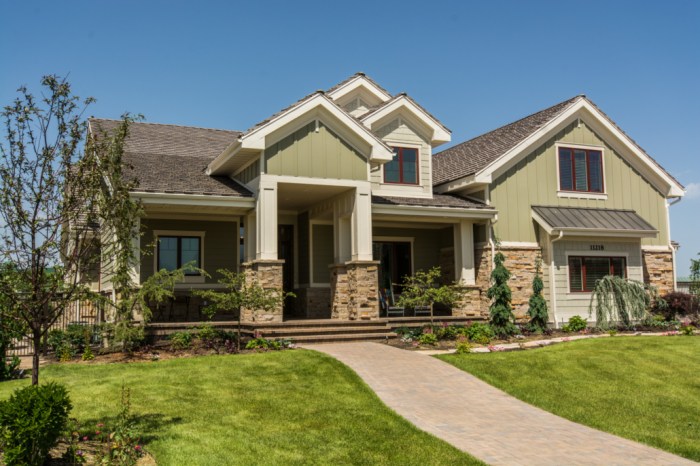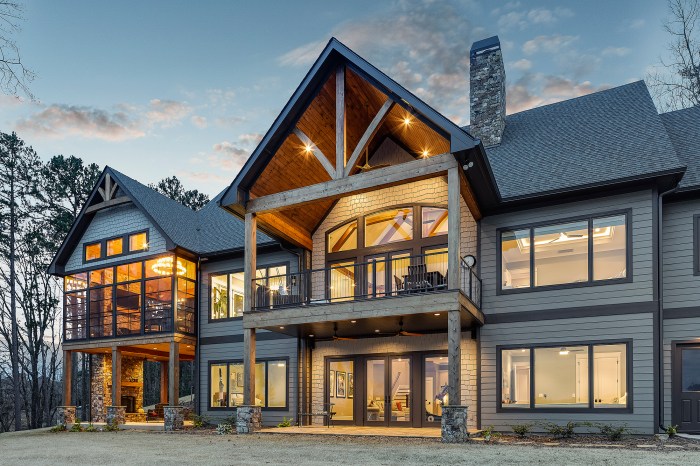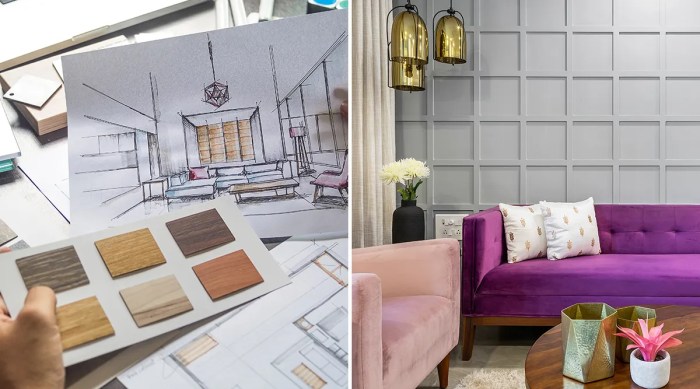As custom home exteriors take the spotlight, this introductory passage invites readers to delve into a realm shaped by expertise, ensuring an immersive and uniquely informative read.
In the following paragraphs, we will delve into the significance of custom home exteriors and explore various aspects of this fascinating topic.
Introduction to Custom Home Exteriors
Custom home exteriors refer to the personalized design and features of the outside of a house, tailored to meet the specific preferences and tastes of the homeowner. This can include elements such as the choice of materials, color schemes, architectural style, landscaping, and outdoor amenities.Customizing exteriors is essential as it allows homeowners to create a unique and individualized look for their property.
By incorporating personal touches and design choices, individuals can showcase their personality and create a space that truly feels like home. This customization also adds value to the property and enhances its curb appeal.Examples of how custom home exteriors can enhance the overall look of a property include the use of high-quality materials like stone or wood for a luxurious appearance, unique architectural details such as custom-built features or intricate trim work, and landscaping elements like gardens or outdoor living spaces that complement the home's design.
These personalized touches can make a property stand out in a neighborhood and create a welcoming and visually appealing exterior.
Popular Customization Options for Home Exteriors
When it comes to customizing home exteriors, there are various popular options that homeowners can choose from to create a unique and personalized look for their property. From materials to landscaping and colors, each element plays a crucial role in defining the overall aesthetic appeal of a custom home exterior.
Common Materials Used in Custom Home Exteriors
Custom home exteriors often feature a variety of materials to add texture and visual interest to the overall design. Some of the most common materials used include:
- Wood: Adds warmth and natural beauty to the exterior, commonly used for siding, trim, and accents.
- Stone: Provides a luxurious and timeless look, often used for cladding, pillars, and entryways.
- Brick: Offers a classic and durable option for exterior walls, creating a traditional and sturdy appearance.
- Stucco: A versatile material that can be shaped and textured to achieve a range of architectural styles.
Landscaping and Outdoor Features in Customizing Exteriors
Landscaping and outdoor features play a significant role in customizing home exteriors, enhancing curb appeal and creating a cohesive look with the architectural design. Some popular options include:
- Plants and Trees: Adding greenery helps soften the exterior and blend the home with its surroundings.
- Patio or Deck: Outdoor living spaces can be customized with seating areas, fire pits, and other amenities to extend the living space outdoors.
- Walkways and Driveways: Choosing materials and patterns that complement the home's exterior can enhance the overall aesthetic appeal.
Impact of Colors and Finishes on Aesthetics
The choice of colors and finishes can greatly impact the aesthetics of a custom home exterior, creating a harmonious and visually appealing look. Some considerations include:
- Color Palette: Selecting a cohesive color scheme that complements the architectural style and surroundings can enhance the overall appeal.
- Finishes: Matte, glossy, or textured finishes can add depth and character to the exterior, creating visual interest and uniqueness.
- Accent Colors: Using accent colors strategically on doors, shutters, or trim can highlight architectural features and add personality to the home.
Architectural Styles for Custom Home Exteriors

When it comes to custom home exteriors, the architectural style plays a crucial role in defining the overall look and feel of the property. From modern designs to traditional aesthetics, there are various styles to choose from when customizing the exterior of your home.
Each architectural style brings its own unique elements and characteristics that can be tailored to create a truly personalized and distinctive look.
Modern Architecture
Modern architecture is known for its clean lines, minimalistic designs, and use of contemporary materials such as glass, steel, and concrete. When customizing a modern home exterior, focus on incorporating sleek finishes, large windows, and open floor plans to achieve a sophisticated and minimalist look.
Traditional Architecture
Traditional architectural styles often draw inspiration from historical designs and feature classic elements like gabled roofs, symmetrical facades, and ornate details. To customize a traditional home exterior, consider incorporating timeless features such as columns, dormer windows, and intricate moldings to create a sense of elegance and charm.
Farmhouse Style
Farmhouse style architecture is characterized by its rustic charm, cozy atmosphere, and inviting porches. When customizing a farmhouse exterior, focus on incorporating wood accents, metal roofing, and wrap-around porches to create a warm and welcoming look that exudes country living.
Architectural Coherence
It is important to maintain architectural coherence between the exterior and interior design of a custom home to ensure a seamless flow and harmonious aesthetic. By selecting architectural elements that complement each other, such as matching window styles, rooflines, and materials, you can create a cohesive and unified look that enhances the overall appeal of your home.
Eco-Friendly Practices in Custom Home Exteriors
Creating eco-friendly custom home exteriors involves using sustainable materials and construction techniques that minimize environmental impact and promote energy efficiency. By incorporating these practices, homeowners can reduce their carbon footprint and contribute to a greener future.
Sustainable Materials and Construction Techniques
When it comes to eco-friendly custom home exteriors, using sustainable materials is key. This includes options such as reclaimed wood, recycled metal, bamboo, and low-VOC paints. Additionally, employing construction techniques like passive solar design, proper insulation, and energy-efficient windows can further enhance the sustainability of the home.
Benefits of Energy-Efficient Features
- Reduced energy consumption: Energy-efficient features such as LED lighting, solar panels, and high-efficiency appliances can help lower utility bills and decrease overall energy usage.
- Improved indoor comfort: Proper insulation and ventilation systems contribute to a more comfortable living environment by maintaining consistent temperatures and indoor air quality.
- Environmental impact: By reducing energy consumption, eco-friendly features in custom home exteriors help lessen greenhouse gas emissions and protect the environment.
Innovative Eco-Friendly Designs
- Green roofs: Installing a green roof with vegetation not only adds visual appeal but also helps regulate indoor temperatures and reduce stormwater runoff.
- Solar shading: Incorporating elements like solar shades or pergolas can provide shade during hot months, reducing the need for excessive air conditioning.
- Rainwater harvesting: Collecting and using rainwater for landscaping or irrigation purposes is a sustainable practice that conserves water resources.
Outcome Summary

In conclusion, custom home exteriors offer a canvas for personal expression and creativity, transforming houses into homes with distinct character and charm. Dive into the world of custom home exteriors and discover the endless possibilities for enhancing your living space.
Question & Answer Hub
What are some common materials used in custom home exteriors?
Common materials include wood, stone, brick, and metal, each offering unique aesthetics and durability for personalized exteriors.
How do colors and finishes impact the aesthetics of a custom home exterior?
Colors and finishes play a crucial role in defining the style and visual appeal of a custom home exterior, influencing its overall look and feel.
Why is architectural coherence important in custom home design?
Architectural coherence ensures a harmonious flow between the exterior and interior design elements, creating a cohesive and visually pleasing living space.









